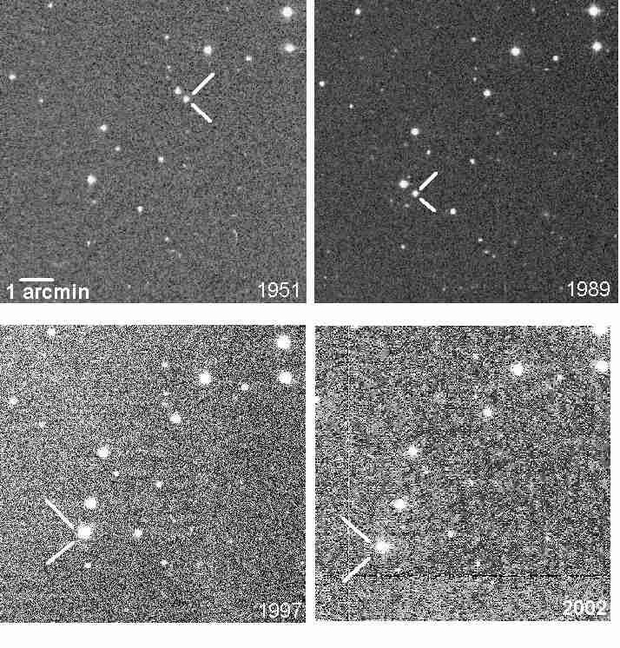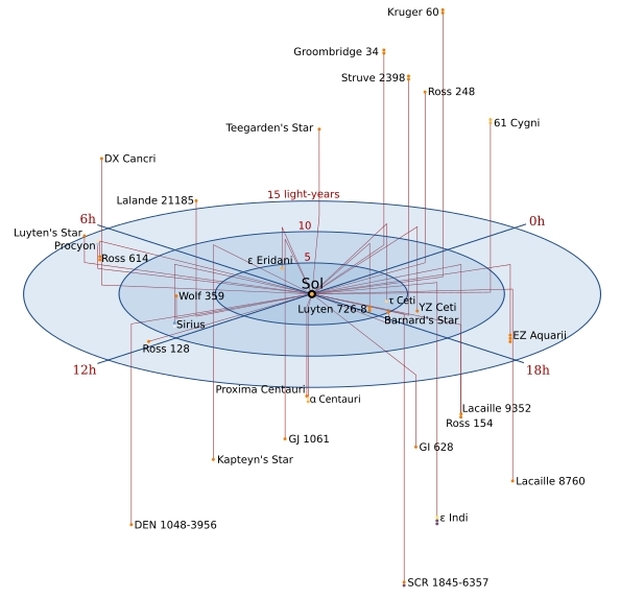I have a number of things to say about Teegarden’s Star and its three interesting planets, but I want to start with the discovery of the star itself.
Here we have a case of a star just 0.08 percent as massive as the Sun, an object which is all but in brown dwarf range and thus housing temperatures low enough to explain why, despite its proximity, it took until 2003 to find it.
Moreover, conventional telescopes were not the tools of discovery but archival data. Bonnard Teegarden (NASA GSFC) dug into archival data from the Near-Earth Asteroid Tracking program, surmising that there ought to be more small stars near us than we were currently seeing. The data mining paid off, and then paid off again when the team looked at the Palomar Sky Survey of 1951. This was a team working without professional astronomers and telescopes.

Image: Teegarden’s Star was subsequently identified in astronomical images taken more than 50 years ago. Credit: Palomar Sky Survey / SolStation.com.
That it took until 2019 to announce evidence of planets reflects the fact that for some time, we had trouble even coming up with a workable parallax reading, one that finally produced a distance of 12.497 light years. There are no transits at Teegarden’s Star, so the discovery data on the first two planets came through radial velocity studies conducted with the CARMENES instrument at the Calar Alto Observatory in Spain. In 2024 a third planet was found, likewise by RV.
Teegarden’s Star compels attention because of those planets, and in particular Teegarden’s Star b, which orbits just inside the habitable zone with an orbit lasting about five days. Its minimum mass, calculated from the radial velocity data, is 1.05 times that of Earth, but recall that because of the limitations of the RV method, we can’t know the orbital inclination of a world that is likely larger. The primary is relatively quiescent by red dwarf standards, and indeed produces flares that would not be problematic if planet b retained an atmosphere.
That last note is important, because the whole question of how long the planets of young red dwarfs retain an atmosphere is crucial. Teegarden’s Star is about eight billion years old and, as I mention, comparatively calm. But young red dwarfs can spit out enormous flares and present serious problems for atmospheric gases, to the point that the atmospheres may be depleted or destroyed altogether. We need to come to grips with the possibility that red dwarfs may simply be inhospitable to life, a notion skillfully dissected by David Kipping in a recent paper that I plan to address in the near future.
For now, though, let’s take a brief look at a new paper from Ryan Boukrouche and Rodrigo Caballero (Stockholm University) and Neil Lewis (University of Exeter). The authors tackle climate and potential habitability of Teegarden’s Star b, noting that its proximity puts it in the catalog for study by next-generation observatories. The team uses a three-dimentional global climate model (GCM) to study habitability, including position in the habitable zone and the question of surface climate if there is an Earth-like atmosphere.
The interest in Teegarden’s Star draws not only from its Earth-mass planets – which Boukrouche and colleagues see as prime fodder for future telescopes like the ESO’s Extremely Large Telescope and its Planetary Camera and Spectrograph – but the effect of flare activity on atmospheres. The authors assume that Teegarden’s Star b is tidally locked given its tight orbit (4.9 days) around the primary. They consider values for surface albedo which approximate first an ocean-dominated surface and then a surface dominated by land masses. Here the discussion reaches this conclusion: “Although the sensitivity to surface albedo is… relatively small, it illustrates that the habitable zone does depend on factors intrinsic to the planet, not just on orbital parameters.”
The results indicate that this intriguing planet may be habitable under these atmosphere assumptions, but if so, it is still close to the inner edge of the habitable zone. Indeed, of two different orbital distances chosen from earlier papers investigating this planet, one produces a runaway greenhouse effect that would prevent the presence of liquid water on the surface. Fittingly, the authors are sensitive to the fact that the habitability question hinges upon the configuration of their models. Citing studies of TRAPPIST-1, they note this:
…different GCMs configured to simulate the same planet can produce a range of climates and circulation regimes (presumably owing to differences between the parameterizations included in each model). For example, models capable of consistently simulating non-dilute atmospheres may explore the possibility that under a range of instellation values, the planet’s atmosphere might be in a moist greenhouse state (Kasting et al. 1984) instead of a runaway, where water builds up enough that the stratosphere becomes moist, driving photodissociation and loss of water to space.
Installation is critical. The classic problem: We need more data, which can only be supplied by future telescopes. Teegarden’s Star remains highly interesting, but if we have yet to nail down the orbital distance of a planet so close to the inner edge of the habitable zone, we can’t yet make the call on how much light and heat this planet receives. And the authors themselves point out that the origins of nitrogen on Earth are not completely understood, which makes guesses at its abundance in other worlds’ atmospheres problematic.

Image: Even in our local ‘neighborhood,’ the data on Earth-mass planets is paltry, and our investigations rely heavily on simulations with values plugged in to gauge the possibilities. New instrumentation will help but it’s sobering to realize how far we are from making the definitive call on such basic issues as whether a given rocky world even has an atmosphere. Image credit: Inductiveload – self-made, Mathematica, Inkscape. Via Wikimedia Commons.
Let me just suggest that this is where we are right now when it comes to key questions about life around nearby stars. Plugging in the necessary data on any system takes time and, when it comes to Earth-mass planets around red dwarfs, the kind of instrumentation that is still on the drawing boards or in some cases under construction. Given all that, we’re going to have quite a few years ahead of us in which we’re constructing theories to explain what we see without the solid data that will help us choose among myriad alternatives.
The paper is Boukrouche, Caballero & Lewis, “Near the Runaway: The Climate and Habitability of Teegarden’s Star b,” accepted at The Astrophysical Journal Letters. Preprint available.



Even under perfect conditions, the spectrum of this star will barely allow terrestrial photosynthesis. Either the local life would need to be able to use much longer wavelengths for photosynthesis, or just sip the available energy with the much lower blue light available. It is the opposite of macroalgae in the sea, where red algae at depths can still access the blue light needed for photosynthesis that penetrates clear water. If photosynthesis is unavailable, then life will be chemotrophic and anaerobic by default, even after 8bn years of evolution. If complex life evolved, it would be slow-moving, perhaps even dominantly sessile like plants, and limited to habitats where chemical energy was available. Would a planet still have active ocean vents or volcanoes to provide that energy?
If there were any life, it would be very interesting to study the ecosystems and energy flows of such a world. Would it mimic some of our abyssal oceans or crustal life, or have evolved biology and forms very different from terrestrial life?